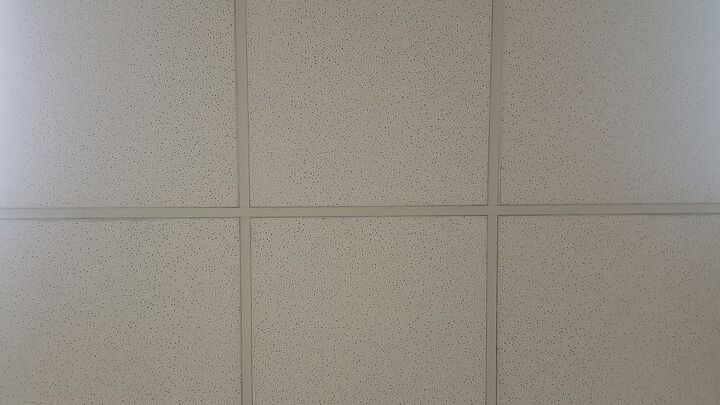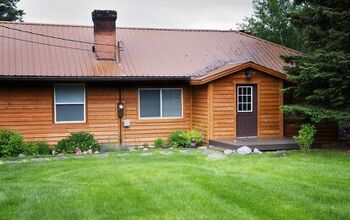2022 Drop Ceiling Cost | Rates Per Square Foot

Whether undertaking a renovation or a new construction project, costs will always heavily factor into the endeavor. Some aspects of the home can run quite a bit more than others, so determine costs beforehand is important.
The average drop ceiling cost is $1,800, and that includes materials and labor. Homeowners spend an average of $3.50 per square foot on labor, $16 per tile, and $1.37 per square foot for grid rails. Additional costs include $525 per ceiling fan and $127 per LED light panel.
Do You Need Wall and Ceiling Contractors?
Get free, zero-commitment quotes from pro contractors near you.

What is a Drop Ceiling?
If you are unfamiliar and looking to take on this DIY project, perhaps the best place to start is with what exactly a drop ceiling is in the first place. It is important to note that the drop ceiling is not technically needed.
A drop ceiling is a secondary ceiling. It hangs below the structural ceiling. In most cases, a drop ceiling is put in to mask the infrastructure of the building. That can include, wiring, piping, and ductwork. The dropped ceiling allows for easy access for repairs while hiding the less appealing aesthetic of all those components.
What a Drop Ceiling Costs: the 10,000-foot View
Before we get into breaking down the costs of a drop ceiling, let’s go a little further out to gauge the costs. There are two parts to a drop ceiling: the grid and the tiles. The grid attaches to the walls through the use of beams while the tiles close everything off and give it that finished look.
For the average 130-square foot of suspended plastic trim and ceiling, you are looking at about $1,400. Depending on who you go with for the installation (if you don’t do it yourself), the labor can vary. Depending on the location and the size of the task, labor should cost somewhere between $2 and $5 per square foot.
Costs can escalate if you begin insulating tiles, adding rail covers, or adding in lighting. Drop ceilings can be as simple or complicated as you want, but there are associated costs that go along with it all.
The Impact of Materials
Perhaps one of the first things that you will do when considering constructing a drop ceiling is to consider the materials that you are going to use. What material you chose can offer access to other features and each will carry its own cost with it.
Plastic
Plastic is one of the most common materials to choose from. That is because it has a single huge advantage: ease of installation. If you are looking to get a drop ceiling installed in short order, plastic is the way to go.
Even better, you can either use grid nails to drop in the tiles to install them quickly. Plastic is easy to paint, which comes in handy if there are any minor dents and dings. Plastic is not quite as durable, though it is the second-cheapest material on the list at a cost of $5 to $9 per square.
Minera Fiber or Fiberboard
When cost plays a major role, fiberboard or mineral fiber is the way to go. It can vary heavily in cost — $1.10 to $6.60 per tile without labor factored in – but has the potential to be the cheapest install of the bunch.
This material is also great if you want a quieter room. This is far and away the most common material used for drop ceiling installations. Their ease of installation and budget-friendliness are major reasons why. That said, make certain that you install these in a dry environment. When they get wet, they develop discoloration or unsightly yellow stains from the moisture.
Tin or Another Metal
There is one thing that should be quickly noted. Tin tiles are not actually made from tin. They are made of a copper, brass, or aluminum mix to mimic the classic feel and look of tin. Even better, you can choose from a number of patterns to match the aesthetic of your home.
Metal is more durable than just about any other type of material, but the installation is much tougher. Not only that, the cost of a metal or tin drop ceiling is substantially more. You can expect to pay between $12 and $20 per tile for a metal or tin drop ceiling.
Wood
Looking to go with something a bit more rustic or even luxurious when installing a drop ceiling? Wood is a great choice if that is the case. Wood provides a more elegant look and there are several different types of wood available to choose from.
If you live in an area with a lot of moisture or humidity, wood may not be the best option. Wood is prone to rot and warping when there is a lot of moisture in the air. Furthermore, wood is expensive. You can go as cheap as $9 per tile but something like cherry wood can run you as high as $68 per tile for your installation.
What is the Average Cost of Installation per Square Footage?
Now that we know the impact materials can play (not even counting labor), you might be feeling rightfully confused. Instead, let’s take a look at another important factor: the square footage. It kind of goes without saying, but the larger the project, the more expensive that it will be.
Keep in mind that the type and design of the drop ceiling can play a role in the costs as well. Should you decide to have a professional perform the installation, that can raise costs as well. Let’s say that you choose a professional installation. The average would work out to something like $9.30 per square foot. Here is what that would look like for various square footages:
| Square Footage | Cost |
| 70 square feet | $651 |
| 100 square feet | $930 |
| 130 square feet | $1,209 |
| 160 square feet | $1,488 |
| 190 square feet | $1,787 |
| 220 square feet | $2,046 |
Again, keep in mind that this is the average for a fiberboard. The more expensive the material, the higher the costs of the installation. Another thing to keep in mind is the worth of your time. Is it worth the money saved to do the installation yourself or would that shorter install time be better for you?
Grid Cost
The tiles might seem like the only thing worth considering but they are just half of the suspended ceiling. Don’t forget the second part of the drop ceiling: the grid. Most grids are in a T-bar system. They attach to the wall and they are what hold the tiles or panels in place.
If you plan to purchase grid rails, add another $1.50 to $2.25 per square foot to your costs. Keep in mind that labor is not included, so you can add in another $35 to $80 depending on the contractor when it comes time for them to install. Here is what your cost for gridding would look like per square foot:
| Square Footage | Cost |
| 70 square feet | $105-157 |
| 100 square feet | $150-$225 |
| 130 square feet | $195-$293 |
| 160 square feet | $240-$360 |
| 190 square feet | $285-$427 |
| 220 square feet | $330-$495 |
Additional Options That Impact Price
What happens if you want to go with something more than the basic drop ceiling? There are more than a few additional items that can be included but those come with increased costs. You may even be able to customize the entire project to fit your specific design aesthetic.
Drop Out Tiles
For those looking to take extra precautions against fire, drop-out tiles are a must. These tiles are heat sensitive and work in tandem with the fire system. When a fire starts, the tiles will melt and eventually fall away from the ceiling. That allows the sprinkler system to trigger and put out the fire.
Also known as melt-away tiles, you are looking at a cost of $95 to $100 for a single two-by-four tile. Adding fire safety to your drop ceiling comes at a major cost but could potentially save your home in a bad situation.
Ceiling Fans
Drop ceilings are typically installed in places like basements, where temperatures are already naturally cooler. If you are looking to increase air flow and create a cooler space, adding in a ceiling fan may be the best option.
The costs of the ceiling fan depend on where the install takes place and what type of ceiling fan that you go with. On average adding a ceiling fan can raise your install price by anywhere from $450 to $700 for each fan installed.
Light Panels
Can’t have a ceiling without lighting, right? There are more than a few ways to do this with one of the most popular being LED panels. They sit flush with the drop ceiling and usually a panel or two are enough to fill a fairly large space.
LED light panels typically get installed to avoid the need for ceiling fans or additional lighting fixtures. That said, the cost of the average LED light panel will cost somewhere between $85 and $170 depending on the quality.
You can also go with a recessed lighting fixture, which will start the pricing at about $30. If you go with recessed lighting, you will need controls to go with it which runs anywhere from $20 to $35 for each switch.
Do You Need Wall and Ceiling Contractors?
Get free, zero-commitment quotes from pro contractors near you.

Let’s Talk Labor Costs
Not everyone wants to tackle a project like this themselves. It is not the hardest installation in the world but what is your time worth? That cost may be worth whatever time it would take for you to perform the installation.
The average labor, when done yourself, is between $2 to $5 for each square foot. That would work out to anywhere from $240 to $1,000 for a 120-square foot room. What if you want to hire a contractor? Here is what to consider.
Hiring a Contractor
If you are not confident enough to tackle this project, going with a local contractor is a great move. They may also work with you to give you a better deal on wiring, controls, and lighting. Most contractors charge on a per-hour rate and those rates tend to be higher in larger metro areas.
To hire a handyman, you are looking at $50 to $80 depending on experience and location. For a licensed contractor, those costs escalate to between $70 and $135 per hour. That seems like a lot but they will also get the job done far sooner.
Costs are Important but not Everything
Budgets are budgets. More often than not, they dictate how a project will go. It may seem easy to decide to perform the installation yourself, but don’t immediately write off a contractor. They have the skills and experience to get the job done sooner rather than later, saving you time and frustration along the way.
Related Articles

Ryan Womeldorf has more than a decade of experience writing. He loves to blog about construction, plumbing, and other home topics. Ryan also loves hockey and a lifelong Buffalo sports fan.
More by Ryan Womeldorf












![Popcorn Ceiling Removal Cost [Per Square Foot Pricing]](https://cdn-fastly.upgradedhome.com/media/2023/07/31/9074404/popcorn-ceiling-removal-cost-per-square-foot-pricing.jpg?size=350x220)



![How To Reset A Whirlpool Cabrio Washer [In 5 Easy Steps!]](https://cdn-fastly.upgradedhome.com/media/2023/07/31/9076531/how-to-reset-a-whirlpool-cabrio-washer-in-5-easy-steps.jpg?size=350x220)









